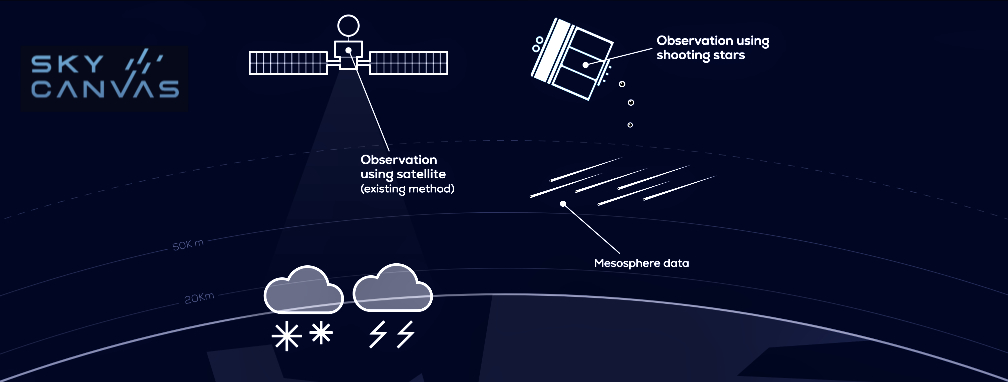
Space tech company ALE has announced the firm’s long-term goal to revolutionize space technology and climate science, with a Web3-mediated decentralized science (DeSci) approach to Earth data collection, analysis, space science and more open, collaborative business models.
ALE will pioneer the development of new Web3-based space science research and development (R&D) to enable a far more efficient distribution of scientific research and policies through decentralized autonomous organizations (DAOs) in the future.
In the first step of ALE’s space science development through DeSci, the company will develop and sell digital content that leverages the appeal of its human-made shooting star project, SKY CANVAS. ALE’s recently launched VIP PASS NFT to the SKY CANVAS Community Club was the company’s first Web3 initiative, to support the world’s first public human-made shooting star event, scheduled to take place in 2025.

How does SKY CANVAS work?
ALE’s proprietary technology recreates natural shooting stars. Natural shooting stars, or meteors, emit light due to the aerodynamic heating of small dust particles when they travel through Earth’s atmosphere at very high speed. ALE recreate this phenomenon by accurately releasing particles that become shooting stars from its satellites when they enter Earth’s atmosphere.
First, meteor-replicating particles are installed into one of its satellites. Then, by controlling the position, speed, and timing of the meteor particles, the human-made shooting stars emit light in the sky at a designated location anywhere in the world. Allowing people all over the earth to enjoy this rare, beautiful, celestial experience.
How does SKY CANVAS enable sustainable climate and environment science?
Climate change action is the most urgent issue facing humanity today. Climate-related disasters have doubled in 20 years, with various other environmental problems emerging such as the impact of climate change on ecosystems. Currently there are limitations on the area of atmospheric data that can be acquired. The basis of climate research is global environmental data, but the ‘mesosphere’ has not been adequately observed, to date, in atmospheric data. This is because the mesosphere is too high for airplanes and balloons, yet too low for satellites.
Studying the path and light emission of SKY CANVAS’s human-made shooting stars will enable ALE to collect new atmospheric data (including wind speed, atmospheric composition and more), with a view to addressing climate change and contributing to weather models. Atmospheric data in the mesosphere from shooting star orbits and emissions have the potential to provide valuable insights into the unknowns of climate and weather. Although it is difficult to acquire data with existing observation methods, with human-made shooting stars, the location and timing of their flow can be determined in advance, and SKY CANVAS will acquire and provide data through observation.
“Although it may seem complex to the layperson, the simple idea that drives the concept of Decentralized Science (or DeSci, for short) is inspired by decentralized technologies such as blockchain to enable a more open, collaborative, and transparent approach to scientific research. In order for the scientific and space technology communities bring about positive sustainability actions to combat climate change and protect the Earth’s biodiversity, for example, we need to take a much longer-term view, and to encourage better ways for industry, academia and governments to work together to achieve the necessary solutions. Our ambition is to use our human-made shooting star satellite technologies to develop better ways of collecting data from the Earth’s atmosphere that promote sustainable space and climate science research and development. And at ALE we are developing new decentralized Web3-based R&D that requires a mid-to-long term investment. To establish schemes with flat decision-making between industry, academia, and government. Ultimately, what we want to achieve is to increase our understanding of the whole Earth’s activities through the centralization and integration of data.”
— Dr. Lena Okajima, founder and CEO of ALE
“In addition to its space entertainment business, ALE is pioneering innovative approaches to fund fundamental science R&D. Through its SKY CANVAS project, ALE aims to collect crucial atmospheric data from the mesosphere, an important layer for understanding climate dynamics . The upcoming ALE-3 satellite will play a key role in gathering climate information specifically from the mesosphere, which is situated between the stratosphere and the thermosphere in the Earth’s atmosphere. The “space entertainment” factor of SKY CANVAS is certainly going to inspire a lot of new interest in space and science, although the scientific value of creating a human-made meteor shower is that it will enable us to reliably observe particles in the mesosphere. And studying human-made shooting stars will also help us to clarify various scientific theories about natural shooting stars.”
— Dr. Gilles Bailet, Research Associate in Emerging Space Technologies at University of Glasgow
